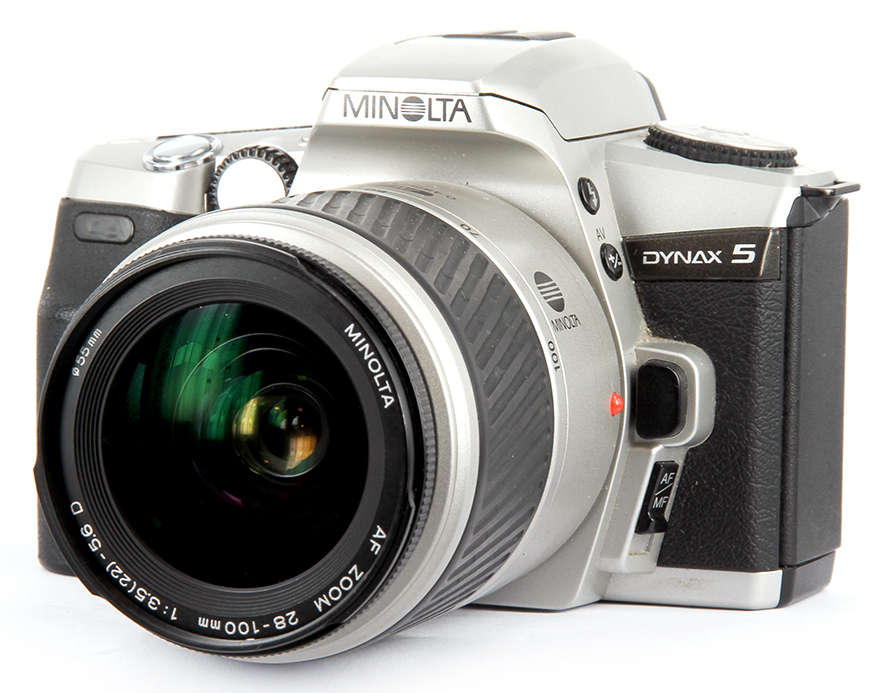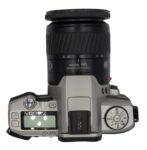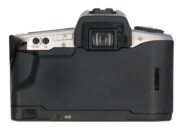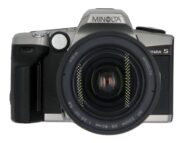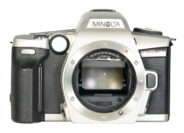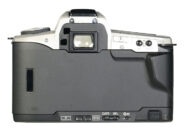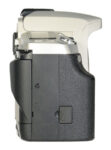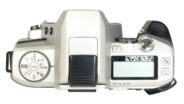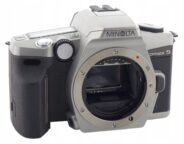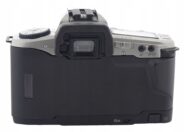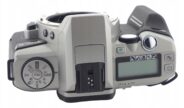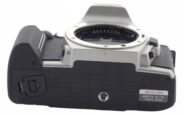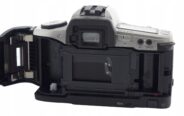Minolta Maxxum 5
aka Minolta A-5
aka Minolta A-Sweet II
aka Minolta Dynax 5
35mm AF film SLR camera
Specification
| Production details: | |
| Announced: | 2001 |
| System: | ● Minolta A (1985) |
| Format: | |
| Maximum format: | 35mm full frame |
| Film type: | 135 cartridge-loaded film |
| Mount and Flange focal distance: | Minolta/Sony A [44.5mm] |
| Shutter: | |
| Type: | Focal-plane |
| Model: | Electronically controlled |
| Speeds: | 30 - 1/4000 + B |
| Exposure: | |
| Exposure metering: | Through-the-lens (TTL), open-aperture |
| Exposure modes: | Programmed Auto |
| Aperture-priority Auto | |
| Shutter-priority Auto | |
| Manual | |
| Physical characteristics: | |
| Weight: | 335g |
| Dimensions: | 127x87x60.5mm |
Manufacturer description #1
Remember as a kid, all those long summer days filled with non-stop activities? Now, the Minolta Dynax 5 makes it easier to capture more of these special moments.
Equipped with the world's fastest autofocus system with super-quick predictive focus controls, the Dynax 5 can easily track, freeze and capture children at play, animals in the wild or any other fast-paced action.
Since the Dynax 5 is replete with the most powerful features, it's ready to handle numerous shooting conditions.
Want to freeze in crystal sharp focus a child playing in a lake? Or how about capturing an enchanting portrait with the perfect balance of light and shadow? With the Dynax 5, you'll possess adept control over both of these demanding shooting environments.
For point-and-shoot simplicity, just switch the Dynax 5 to full-auto P mode. And from the first time you shoot, you'll enjoy concentrating solely on the perfect composition and framing. To indulge your creative side, it's also loaded with a host of sophisticated settings: exposure bracketing, exposure compensation, A.S. and M. modes, and more-plus many custom functions.
*In its class of 35mm AF SLR cameras as of March 2002.
More advanced features than any other camera in its class -- yet it's still one of the world's smallest and lightest.
Naturally, the more places you can bring your camera, the more photo opportunities you'll have. And with the Dynax 5 being one of the most portable AF SLR camera in both size and weight, you'll take it everywhere you go.
Sure, the Dynax 5 has many progressive features which used to be found only on higher-class cameras. Features such as the most advanced autofocus system with highly responsive predictive focus controls, the most powerful specs in its category, a super bright, clear viewfinder, a metal lens mount, and more. And, thanks to Konica Minolta's world-renowned engineers, you'll also find these features smartly packed into a streamlined, user-friendly SLR body which offers the highest level of portability as well as comfort.
The Dynax 5. So powerful. So portable. So perfect.
Ultra-High-Speed AF Control
Compared to any camera in its class, the Dynax 5 is the flat-out world's fastest. That's because it inherits a similar AF technology from the Dynax 7, which is considered the world's fastest in any class. Its shared technology includes a high-power motor to drive the AF system, a high-speed microcomputer, improved efficiency in braking control, faster CCD control processing, improved control algorithm, and a new AF realtime start control. All of which enables its AF control to process multiple tasks while focusing amazingly fast.
*In its class of 35mm AF SLR cameras. As of March 2002, under Minolta test conditions.
Multi-Dimensional Predictive Focus Control
With the most responsive predictive focus control in its class, the Dynax 5 can track faster moving subjects. In fact, it's so responsive, it can even track abrupt changes in speed or direction while maintaining accurate focus. And, unlike other cameras, the Dynax 5's shutter will release the instant the shutter button is pressed. These upgrades were made possible by employing a high-power AF motor, a simultaneous lens drive during the mirror-up movement, and an improved AF algorithm.
Super-Wide 7-Point AF System
Provides optimum flexibility when composing a picture enabling you to achieve an aesthetically balanced framing. The new 7-Point AF System efficiently covers the wide focus area and its sensors are laid out to the "Rule of Thirds," making easy placement of subjects near their corners. The cross-hair sensor in the centre captures the subject's vertical or horizontal contrast orientation. In continuous AF mode, this feature takes care of subject tracking, allowing you to focus totally on composition.
LED Illuminated Super Impose
The Dynax 5 is also the first in its class to possess this convenient feature. Located within the viewfinder, the super impose's red indicator light confirms whether your camera is focused on your subject when there are multiple objects in your scene.
1/4000th s. Ultra-High-Speed Shutter
By employing the fastest shutter speed in its class--1/4000 th s. the Dynax 5 can freeze fast moving subjects with astounding clarity and detail. This permits you to shoot with wider apertures in very bright backlit situations.
3 FPS Ultra-High-Speed Film Drive
At 3 frames per second*, no other camera in its class also lets you enjoy faster continuous shooting of moving subjects. That's because the Dynax 5 utilises a high-power motor, improved sequence of the parallel film drive transport and shutter charging, plus a flying release that was taken from the Dynax 9. You'll count on these upgrades to get more sequential shots of the exciting action you're trying to capture.
*Continuous drive speed based on following Konica Minolta test conditions: focus mode--single shot AF or MF, without date/time imprinting.
14-Segment Honeycomb-Pattern Metering
Ensures precise exposure for your subject even in the most difficult lighting situations. Its metering system collects data--brightness, distance, position of subject and focal length. This data is then analysed to decipher if the shot has normal or back lighting, is a portrait or a landscape, etc., and based on this analysis, the optimum exposure is set.
Spot Metering
The perfect mode for tricky exposure settings such as shooting subjects lit from behind or with high contrast. To achieve the most accurate spot metering of your subject, sensitivity is concentrated in an area that's 5.5mm or 3% of the total frame area.
Various Flash Modes
- Fill Flash Mode enhances backlit subjects by lightening up shadows
- For soft, natural light use Flash Cancel Mode
- Red-Eye Reduction eliminates the red-eye effect caused by nighttime flash
- Remote Off Camera TTL Flash Control adds an extra creative dimension while using Minolta Program Flash 5400HS, 5600HS(D) or 3600HS(D)
- Also, while using Program Flash 5600HS(D) or 3600HS(D), Wireless High-Speed Sync lets you shoot in backlit situations using wider than customary apertures with the built-in flash and normal sync speeds
ADI Flash Metering
Attach a (D) lens* and Konica Minolta's ADI (Advanced Distance Integration) will ensure optimum flash metering--regardless of background conditions or subject's reflectance characteristics. Used with Program Flash 5600HS(D), Program Flash 3600HS(D) or even its built-in flash, the Dynax 5 calculates a guide number based on distance from subject, ambient light/pre-flash reflectivity** of the subject and the background to determine the ideal amount of flash.
*ADI flash metering operates only with (D) lenses.
**Does not operate with built-in flash.
Eye-Start Automation
Switch on this unique feature and it'll help you capture exciting candid shots the instant they happen. Sensors in the handgrip and viewfinder automatically activate the AF and AE systems the moment you bring the camera up to your eye--readying you for all the action.
Depth-Of-Field Preview
This convenient feature lets you continuously monitor the depth of field of your image. Thus, making it easy to ensure your subject and background are both in focus, or to check your focus during macro photography.
14 Custom Functions
You can customise your camera according to your shooting style by setting the Dynax 5's time-saving default settings.
Loaded with so many user-friendly features, the Dynax 5 lets anyone take exceptional pictures-right from the first time they look through its bright viewfinder.
Full-Auto P Mode
For point-and-shoot simplicity, just press the P button on your Dynax 5 and it'll do everything but compose your shot-even fire the flash if necessary.
Subject Program Selection
Offering 5 pre-programmed shooting modes, this feature automatically sets shutter speeds and aperture settings by simply pressing the icon button that coincides with your scene. All you do is compose and fire away.
Portrait Mode
Calls dramatic attention to a face. By using a large aperture to provide a shallow depth of focus, the subject remains in sharp focus while the background tends to be a blurred palette of color.
Landscape Mode
This mode adjusts the settings to ensure that a subject placed in the foreground, as well as scenes or vistas in the background, are both captured in detail and in crisp focus.
Close-Up Mode
Perfect for shooting memorabilia, flowers, or anything else that requires getting up close. Macro photography isolates subjects from their backgrounds, giving them a three-dimensional illusion.
Sports Action Mode
Lets you freeze fast moving subjects with detail and clarity. This mode harnesses the continuous autofocus power of the world's fastest AF system in its class.
Night Portrait Mode
Providing a more balanced exposure, this mode produces more details in night or in sunset backgrounds. It reduces background darkness by combining the flash with a longer exposure.
To indulge your creativity, the Dynax 5 is equipped with a wide range of sophisticated creative functions which open you to a world of photographic possibilities.
Aperture/Shutter Priorities & Manual Mode
For exceptional portraits, landscapes or macro images, switch to A (Aperture Priority) mode and shoot with a superior command of your depth of field. With shutter speeds from 1/4000 th s. to 30 s., S (Shutter Priority) mode allows you to go from freezing fast moving subjects in sharp focus to capturing speed-blurred images. For creative nighttime photography, M (Manual) mode gives you total control over shutter release time.
Exposure Bracketing
A feature which allows you to capture up to a 3 frame sequence of a scene where each varies slightly in exposure value. It's the perfect solution for difficult lighting situations and when shooting slides, or when you're looking for more creative results.
Multiple ExposureMultiple Exposure
Create compelling and haunting effects by combining two exposures on a single frame. This mode overrides the camera's automatic frame advance-permitting one shot to be placed on top of another.
Exposure CompensationExposure Compensation
Add your own creative touch to every shot. This feature allows specific over-and-under exposure selections giving you more control over metering, as well as your end result.
ISO Automatic & Manual Setting
Insert a roll of film into the Dynax 5 and it automatically reads the speed, then sets the proper exposure. If you're feeling creative, you can override the auto setting and manually select a desired speed.
Viewfinder
To achieve a clear and bright image field, the Dynax 5 uses the same spherical acute matte as the Dynax 7 for its focusing screen. Plus, a double-sided aspheric element and silver deposition on Dach mirror to sharpen image quality.
NOTE: Brightness as compared to a previous Minolta model using a 28-80mm/f3.5-5.6 lens and at 80mm. All cameras compared under the same conditions.
Minimum Mirror-Up Vibration
To ensure sharp focus while using long shutter speeds on a tripod, the Dynax 5 uses a super-thin, lightweight mirror and balancer to reduce vibration to the lowest in its class.
Film Chamber Lock
A safety feature which prohibits you from accidentally opening the camera and exposing your film. When engaged, the lock indicator next to back-cover release turns red. At the same time, because of the lock's location, it's also designed to provide faster film changing.
Metal Lens Mount
The Dynax 5 has a durable metal lens mount which offers maximum rigidness--even when a heavy lens is mounted.
Manufacturer description #2
CAMERA TYPE: 35mm SLR with built-in flash, autoexposure (AE), and action predictive autofocus (AF)
LENS MOUNT: Minolta A-type bayonet mount
VIEWFINDER: SLR roof mirror type, 90% field of view, Magnification: 0.75X
SHUTTER: Type: Electronically-controlled, vertical-traverse, focal-plane type. Speeds: 30 sec. - 1/4000 sec., bulb. Flash sync speed: 1/125s or slower (synchronizes with all speeds in HSS mode)
FOCUS: Type: TTL phase-detection system, multi metering with cross hair type CCD line sensor metering cell. Autofocus and manual focus modes. AF Sensitivity Range: EV -1 to 18 (ISO 100). AF Illuminator: Built-in with range of 1.0 - 5.0m. Automatically activated in low-light/low-contrast situations. AF Controls: Single-shot, continuous, automatic AF-mode selection
EXPOSURE MODES: P, A, S, M, (PA/PS available) and 5 Subject Program modes (Portrait, Landscape, Close-up, Sports, Night Portrait). Type: TTL metering; direct TTL metering for flash. Metering Cell: 14-segment honeycomb pattern SPC for ambient light and 4-segment flash-metering SPC for flash. Metering Range: 14-segment honeycomb pattern metering: EV 1 - 20, Spot metering: EV 4 - 20 (ISO 100, f/1.4 lens). Film-speed setting: Automatic: ISO 25 to 5000 for DX-coded film. Manual: ISO 6 to 6400 in 1/3 EV increments. Flash: ISO 25 - 1000.
FILM TRANSPORT: Loading: Auto load. Drive Modes: Single frame, continuous advance (3 frames/sec.), self-timer, exposure bracketing, and multiple exposure. Rewind: Auto rewind, manual start (Count-down display). Frame counter: Forward (shows number of exposures taken)
BUILT-IN FLASH: GN: 12 (ISO 100 in meters). Coverage: 28mm angle of view
POWER: Two CR2 lithium batteries
Table of contents
Clickable
Instruction manual
Clickable
Minolta A system cameras
Clickable
- Minolta Maxxum 2xi
- Minolta Maxxum 3000i
- Minolta Maxxum 300si
- Minolta Maxxum 3xi
- Minolta Maxxum 4
- Minolta Maxxum 400si
- Minolta Maxxum 5
- Minolta Maxxum 50
- Minolta Maxxum 5000
- Minolta Maxxum 5000i
- Minolta Maxxum 500si
- Minolta Maxxum 5xi
- Minolta Maxxum 600si
- Minolta Maxxum 7
- Minolta Maxxum 70
- Minolta Maxxum 7000
- Minolta Maxxum 7000i
- Minolta Maxxum 700si
- Minolta Maxxum 7xi
- Minolta Maxxum 8000i
- Minolta Maxxum 800si
- Minolta Maxxum 9
- Minolta Maxxum 9000
- Minolta Maxxum 9xi
- Minolta Maxxum GT
- Minolta Maxxum HTsi
- Minolta Maxxum HTsi plus
- Minolta Maxxum QTsi
- Minolta Maxxum SPxi
- Minolta Maxxum STsi
- Minolta Maxxum XTsi
